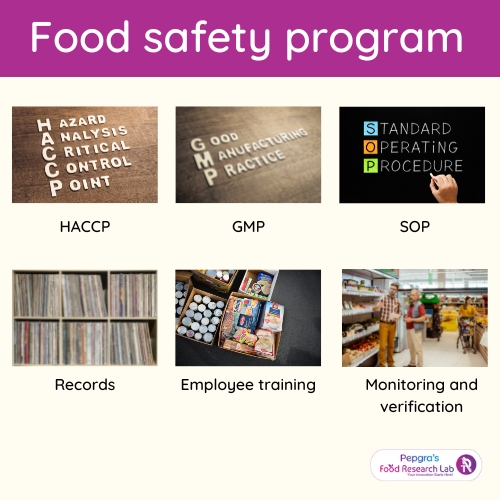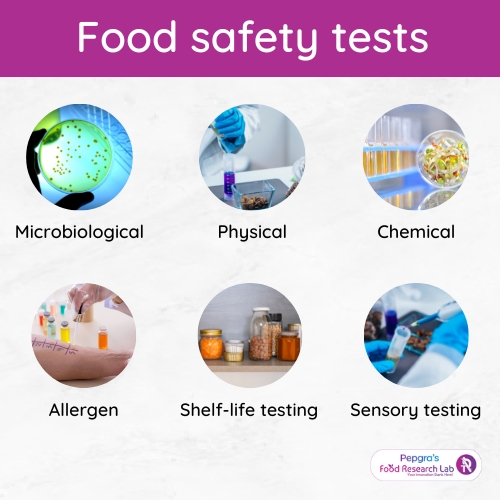
How to ensure the quality and safety of the food product? What are the typical food safety tests performed?
Introduction
Food safety is a significant issue that has an impact on everyone in the world. The term “food safety” refers to all procedures used to keep our food safe. These procedures include handling, storing, and food product development to avoid contamination and maintain an adequate supply of nutrients for a healthy diet. The globalisation of food supply chains, which have grown very long and are made up of numerous participants, including producers/farmers, processors, co-packers, distributors, retailers, and consumers in domestic and international trade, is currently putting food safety to the test. Food contamination has a detrimental impact on food safety and food quality, and it is imperative that the food is free from contaminants. Contaminants are substances unintentionally added to food during food processing and handling. They can be biological (bacteria or fungi can be the contaminants), physical (due to foreign objects like plastics, glass or due to radionuclides) or chemical (like pesticides and any other undesirable substances) [1].
Food Safety Program
A thorough food safety program is essential for ensuring the quality and safety of a food product. The following help achieve the desired objectives:

Hazard analysis: A hazard analysis identifies potential hazards that may occur during the production, processing, packaging, and distribution of food products and makes the food safer to consume. Due to its emphasis on preventing and controlling potential hazards and the fact that it has been implemented globally, the Hazard Analysis Critical Control Point (HACCP) system has been recognised as a more effective method of ensuring food quality than traditional end-product sampling practices [2].
Good manufacturing practices (GMPs): GMP refers to production procedures for food, drugs, and medical equipment. GMPs have been in use since the 1970s, but different nations only formalised them in the middle of the 1990s. The four tenets of good manufacturing practice (GMP) are exclusion; removal of unwanted and foreign matter; inhibition; and destruction of microbial pathogens. Implementing GMPs ensures that food products are produced, processed, and packaged in a clean and sanitary environment [3].
Standard operating procedures (SOPs): SOPs are the directions for producing food products and the backbone for maintaining food safety and quality. The steps are standardised and help keep the employees accountable for their work. Implementing SOPs ensures that all the steps in the production process are conducted consistently and correctly [4].
Monitoring and verification: Testing and inspections serve to monitor and verify the food product development practices and the effectiveness of food safety programs. The food industry currently uses a variety of audit formats, including international standards like ISO 9001, 22000, and 14001. Instead of providing detailed instructions on what a company should do, these standards provide a framework that can be used to create and implement systems that adhere to specific standards for quality, food safety, and environmental protection [5].
Record keeping: Detailed records of all food safety activities, including testing results, inspections, and corrective actions, will help ensure food quality.
Training: The FDA has noted that a third of food recalls between 1999 and 2003 was due to a lack of employee training. Periodic training for employees helps them be updated with the latest occurrences on food safety practices, enabling them to implement them and thus improve food quality [6].
Food safety tests
Some typical food safety tests performed include:

Microbiological testing: This involves testing for harmful bacteria, viruses, and other microorganisms in food products.
Chemical testing: This involves testing for harmful chemicals or contaminants, such as pesticides, heavy metals, and toxins.
Allergen testing: This involves testing for the presence of allergens, such as peanuts, soy, and wheat, in food products.
Physical testing: This involves testing for the presence of physical contaminants, such as glass, metal, or plastic, in food products. Metal detectors and X–rays can help detect metal pieces and bone fragments [7].
Shelf-life testing: Food companies should rely on precise sensory shelf-life estimation methodologies to maximise commercialisation times while guaranteeing the quality of their products. This involves testing the stability and shelf-life of a food product under various storage conditions.
Sensory testing: This involves testing a food product’s appearance, flavour, and texture to meet consumer expectations.
The type of tests required will vary depending on the kind of food product and the regulations governing its production and sale [8].
Conclusion
Food safety and quality play a crucial role in food acceptability by consumers. Following food safety practices at every stage from production, processing, packaging and distribution helps scale up the reliability of a company‘s products and protect consumer health.
How the Food Research Lab can help
The Food Research Lab offers B2B service to its clients in food product development. It assists them at every step, from research to product development to sensory evaluation and keeps a close eye on market trends and consumer needs, ensuring that every product is successful.





